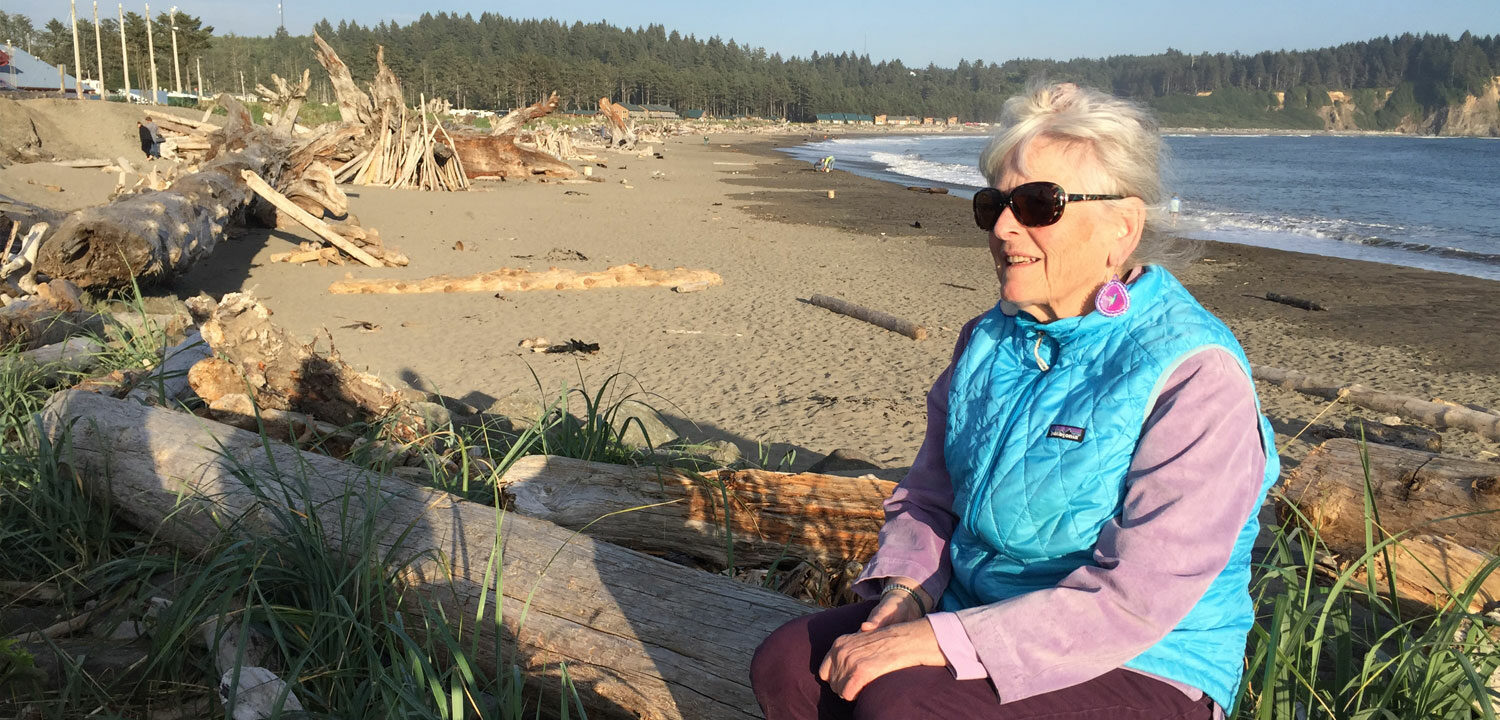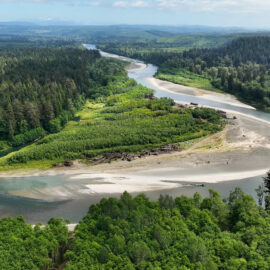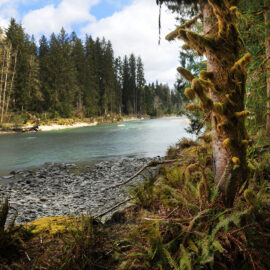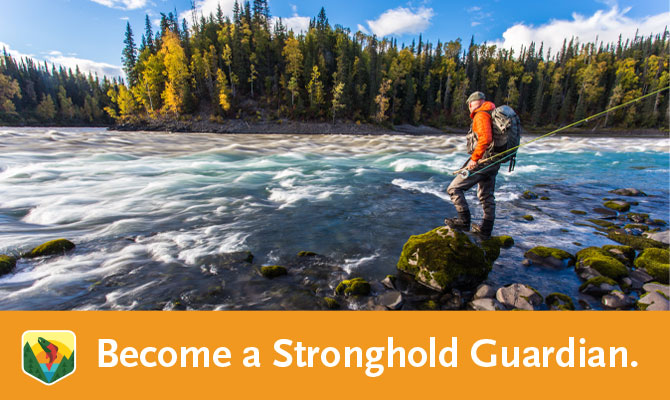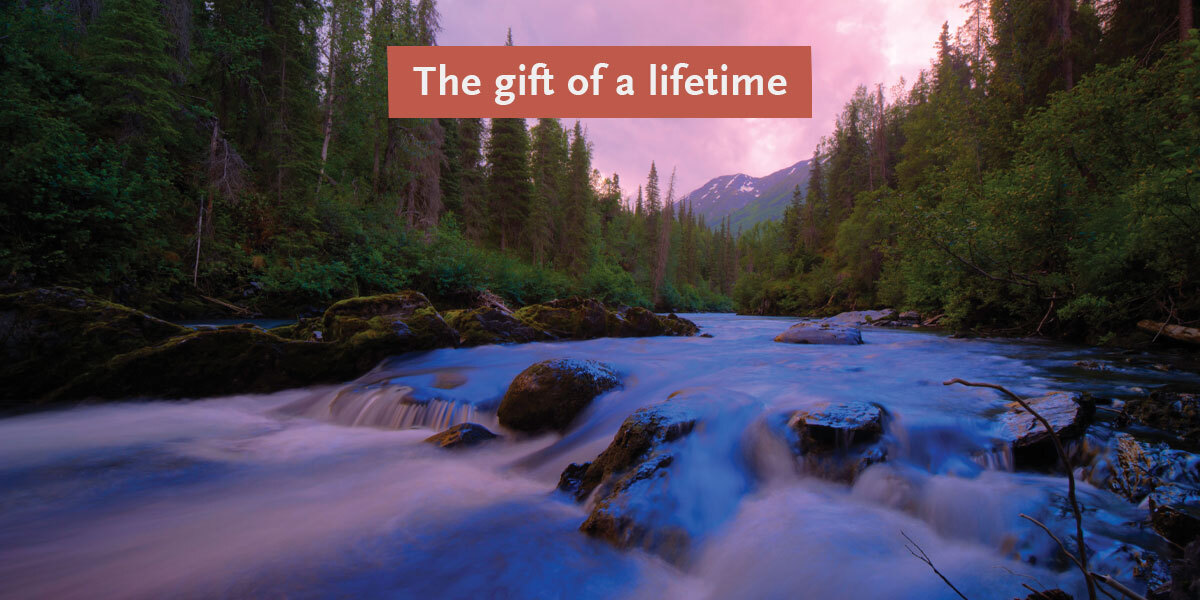As part of our 25th anniversary this year, we are calling out partners and individuals who have made a difference in salmon conservation.
Katie Krueger, geologist and attorney, worked with Quileute Natural Resources* in Washington for 20 years as a lawyer and environmental policy analyst – working to grow the entity’s natural resources program capacity and lines of communication with with state, federal, and tribal governments. She has served as a close partner with WSC as a board member on the Washington Coast Salmon Partnership, which WSC helped create in 2006.
I joined Katie and Devona Ensmenger, our Washington Senior Program Manager, in the small community of La Push, located at the mouth of the Quillayute River on the Pacific Coast. Katie, who recently retired, used to work just up the river in an office with a majestic view of James Island. We had gathered there for the life celebration of Melvin (Mel) Moon, Jr., a long-time advocate of tribal rights and resource conservation who had served as Director of Quileute Natural Resources for over 30 years.
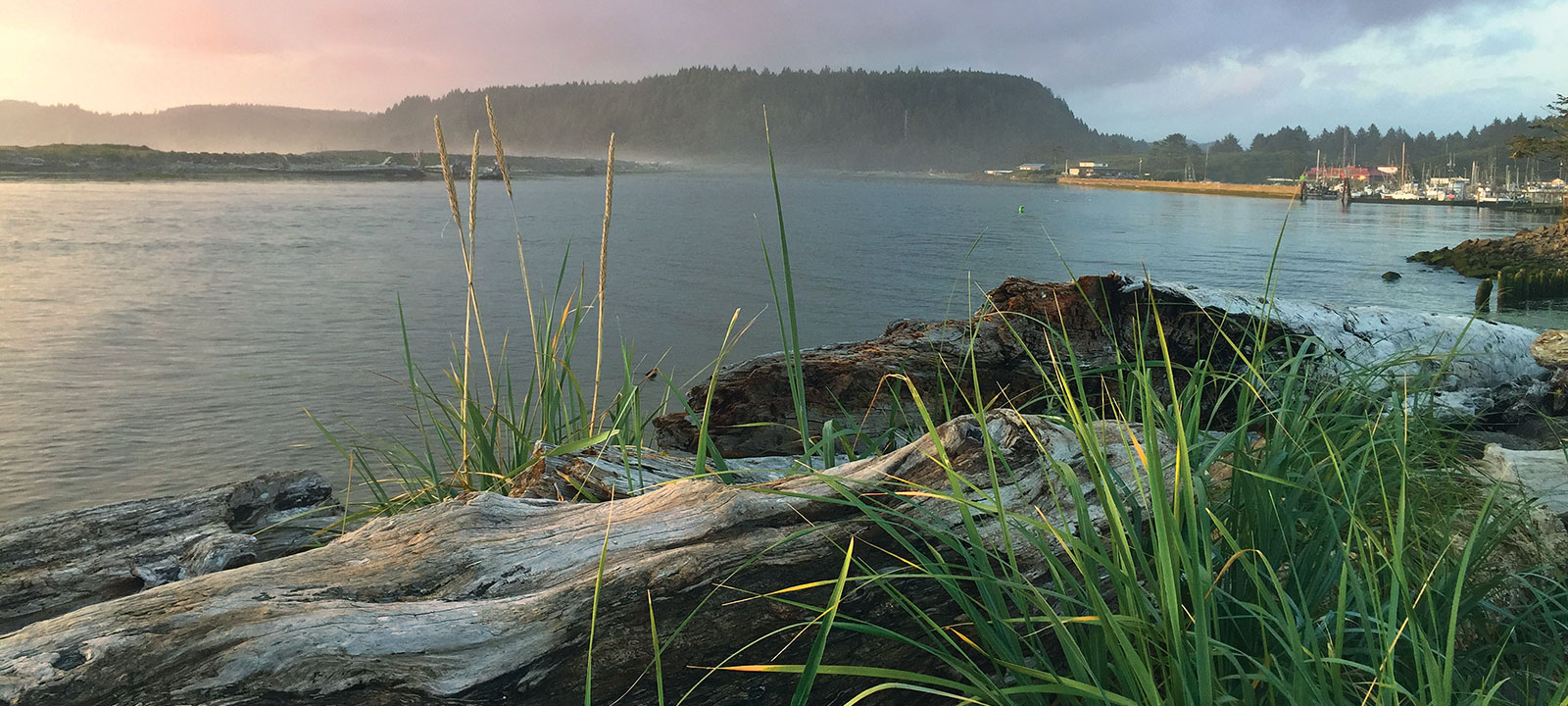
How did the tribe overcome its obstacles and come to lead salmon restoration and natural resource issues?
For a tribe like the Quileute, it’s very challenging to assert their rights when initially their reservation lands were limited to one square mile on the coast (later enlarged to two square miles); it requires ongoing cooperation with the actual landowners to complete natural resources projects that assure good habitat will continue into the future.
Despite the very limited size of the reservation at the Quillayute River mouth, the tribe has vast treaty rights that extend some 70 miles north-south and 40 miles out into the Pacific. On land, the entire drainage basin of the Quillayute (some 800+ square miles) as well as independent small watersheds and parts of Lake Ozette are included. But defining this fishing treaty right has been an ongoing process, starting with the original U.S. v. Washington “Boldt decision” and ongoing even today, with defense of ocean rights (in court as of this writing).
This is one of the areas where Quileute Natural Resources and my supervisor, Mel Moon, had a real impact. Mel was a fisheries manager by training but his special gift was to see the big picture and to communicate that to others in a way that built bridges among diverse groups. In 2015 he was a major organizing force between Quileute and Quinault, and between attorneys and non-attorneys, as well as a witness in that major U.S. v. Washington court case that defined our ocean fishing rights. Evidence for this case required engagement of a number of experts in the diverse fields of anthropology, linguistics, and marine biology. Mel’s vast experience helped guide the legal team towards a win in the federal trial court.
He was instrumental in the creation of the Intergovernmental Policy Council for that part of the Washington Coast inclusive of the marine sanctuary. It provides a forum for the tribal, state, and federal governments within the sanctuary boundaries to discuss treaty rights and to coordinate activities in co-managed marine ecosystems. Mel was primarily a marine fishery guy – believing black cod, halibut, and Dungeness crab were the “bread and butter” for the tribe, but he recognized the important role of salmon in cultural, indigenous identity and for providing for personal or subsistence fishing.
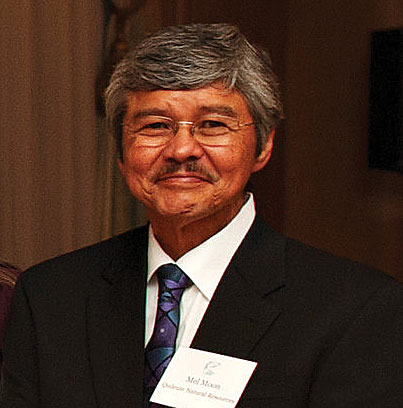
Note: Earlier this year Mel was the first recipient of the Billy Frank Jr. Leadership Award for his work on the advancement, protection and recognition of tribal sovereignty, treaty reserved rights and natural resources.
Mel was an incredible visionary. He kept at his goal and he didn’t allow anything to disparage him. He was a marvel to watch. Some of the lawsuits and debates got heated. In a sea of people losing control, he was not. He was completely calm. He would sit and listen and then at the very end of the meeting he would give the final remarks – thoughtful and constructive. I learned a lot from him.
I learned a lot from all of the people at QNR. They are quite a group – every one of them top notch. Everything was a team effort. You couldn’t do your job right unless you consulted with all the other in-house specialists – fisheries biologists (marine and freshwater), timber and wildlife biologists, water quality and GIS specialists, as well as parallel resources in the state, federal, and tribal agencies.
What were some of the first projects you tackled in your time there?
After the early U.S. v. Washington decisions in 1974 (trial court) and 1979 (U.S. Supreme Court), the government started to appropriate funds to the Tribes, to manage fisheries, since they had been deemed “co-managers” with the state. Grant awards and government appropriations covered not just staffing for management, but also program dollars for field work and research. For fisheries, projects ranged from spawning surveys to habitat restoration (e.g., culvert replacement or bank stabilization) to water quality and quantity monitoring and later on climate change. Things like weed control, which is a big issue for maintaining healthy habitat on land and in water, I initially had to make the case for, to be recognized as legitimate salmon habitat restoration. A restoration project for knotweed removal was the first of its kind the Bureau of Indian Affairs ever funded, which opened up the door for other groups to receive that kind of funding.
One of my first proposals was to the Bureau of Indian of Affairs for a watershed analysis on the Dickey River (a tributary of the Quillayute). These analyses evaluate how major timber harvests will impact salmon by assessing all aspects of their habitat, physical (e.g., rain on snow) and biological, in close partnership with the landowner and co-managers, and make recommendations to protect the fishery, accordingly. (Similar ones had been done on other tributaries of the Quillayute before I arrived.) The Dickey is one of the major coho-producing rivers in Washington State, so protecting its coho fishery is critical for tribal and non-tribal communities, alike.
How did you first connect with WSC?
In 2004 we worked with James Starr, John McMillan, and Dave Moskowitz from WSC and land owner Becky Dixon on a Lead Entity grant to buy portions of Elk Creek habitat, part of the larger Calawah River basin. The Dixons were concerned about the proposed clearcutting by local timber groups and they wanted to convert some of their land to public access and assure it remained forested to protect salmon. WSC ended up raising about $100K in private funds to match the Salmon Recovery Funding Board’s public funds. The spawning surveys from the Quileute helped provide the justification for the designation – as they were able to prove that up to 30% of Calawah spawning coho were found in this little two-mile stretch of creek on the property, based on indexed surveys. (Note: The 256 acre Elk Creek Conservation Area was established in 2011 and deeded to the North Olympic Land Trust.)
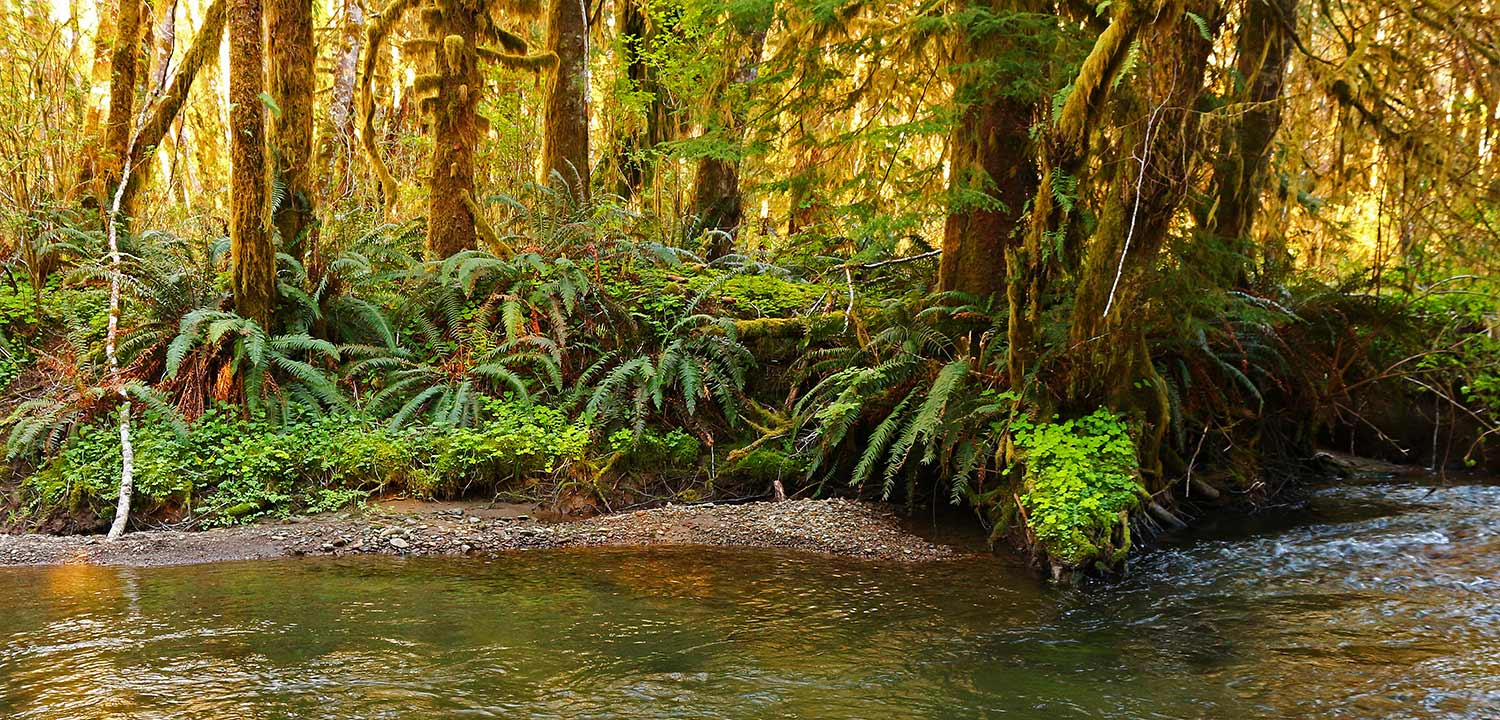
Devona: I first remember coming to Forks for Lead Entity group meetings starting in 2006 after I moved to Port Angeles and trying to be a fly on the wall. Trust has to be earned. I did a lot of observing before speaking. I eventually became an active member of the group and helped with technical, planning and expansion efforts.
One thing quickly became clear to me: the coast was like an orphan. They were neglected financially and capacity-wise due to the policy focus of federal and state governments on threatened and endangered animals.
I remember how WSC started to challenge that paradigm and launched the North American Salmon Stronghold Partnership. As part of that effort I was tasked in 2009 with identifying salmon strongholds and worked with the watershed groups, tribes, federal and the state governments to enlist their help in evaluating the health of salmon and steelhead populations. I remember Mel brought all of QNR staff which, to me, demonstrated his commitment to our common vision. I also worked with the Lead Entity to re-organize and create a regional entity that could compete with other regional salmon recovery groups for funding.
Who else did you partner with in your work?
Because the Quileute had a vast treaty area with off-reservation rights, but a very small reservation, partnering with landowners and the managing agencies for these lands was essential. Only in a few cases was the work limited to just Quileute. Most of the grants were very competitive, pitting tribe against tribe or even non-tribal entities for the same pot of money.
For watershed analysis in the Dickey, Sol Duc and Calawah River basins, the private and public timber landowners were a great help, such as Rayonier Timber Company, USDA Forest Service, and Washington Department of Natural Resources. They were glad to work with us because they were required to do the watershed analysis and restoration work, and we could go out and get the grants to help pay for them. Later we cooperated on grant work to meet the WSA obligations for restoration, and their engineering for road and culvert work was a major in-kind contribution that kept grant budgets down.
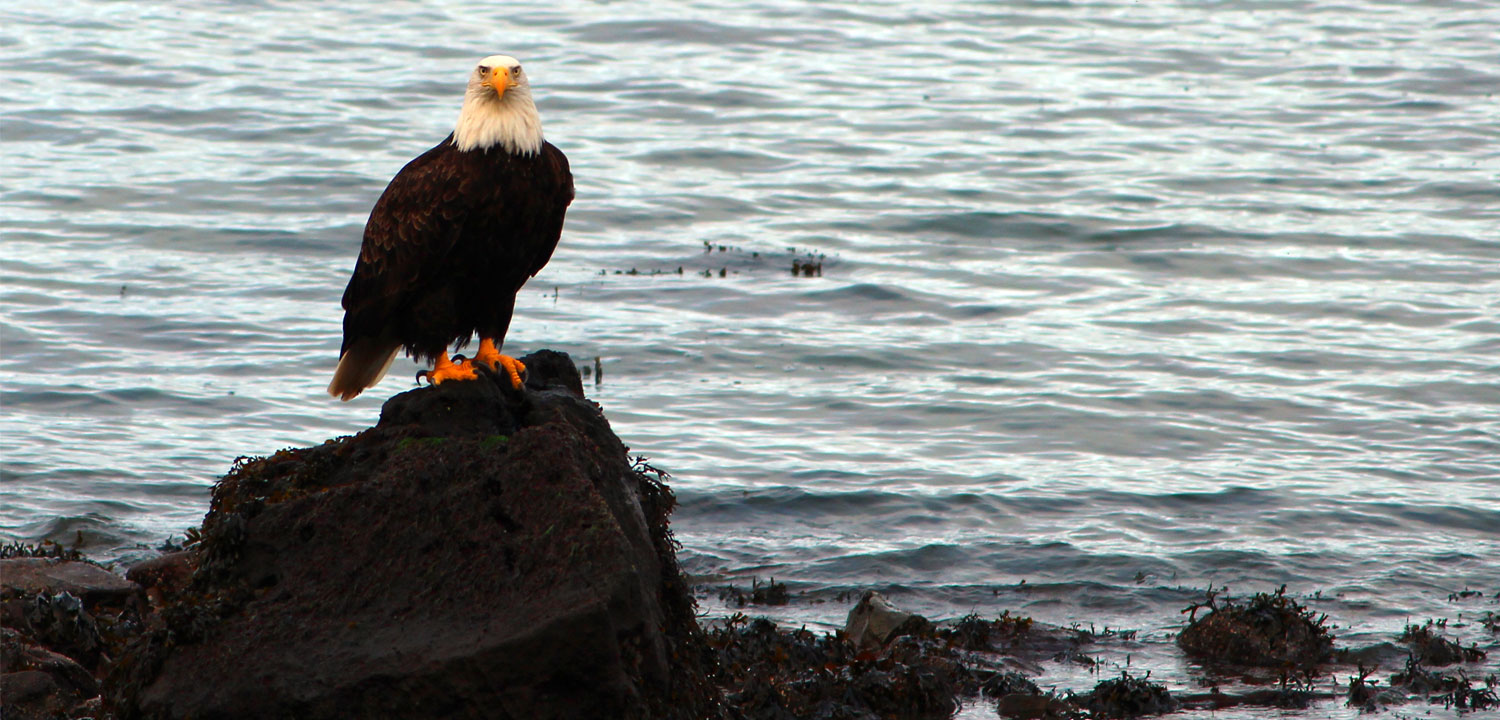
What are some of your favorite moments on the coast?
One time I was working on a grant at the QNR headquarters here near the water. There is a tree outside my office window called the Eagle Tree – a favorite roosting spot. Four eagles were chittering non-stop and I muttered under my breath “why won’t they shut up?!” Then I caught myself. So many people would kill to work this close to eagles. I’ve seen eagles clasp talons during mating season. How many people get to see that?
I’ve seen whales, river otters, and sea lions and watched fishermen capture salmon from the river. Seasonally, we see brown pelicans, herons, and a variety of ducks and geese. Seagulls of course are year-round. Behind our building the elk browse each winter and deer are likely to show up at any time. I’ve luckily never had a bear encounter, but I’ve heard them and had lots of evidence of their proximity. I’ve been carried away by the current on hikes when I underestimated the strength of the water. Luckily it just floated me downstream to a quieter spot where I could get out.
Devona: I had a similar experience on the first couple weeks of my job at WSC! We were at Mt. Tom Creek of the Hoh doing a survey. The river was not much higher than my knee. I had been in much deeper water before as a fisherman, but she took me. She took me under, rolled me, soaked me and I said “Hello mother Hoh! I have a much deeper respect for you now.”
I used to live near a tributary of the Sol Duc – Shuwah Creek. One time when the channel was drying up and the little fry were frantically trying to get back into the mainstem, I was determined to save as many as I could and would scoop them up and transport them out of these trapped pools.
Salmon are amazing animals. Their whole life history is so unbelievable, when you think about what they face. I got a real high for being able to help the salmon population and being able to work with a tribe who is so connected to it as a natural resource. Literally living off it.
Tribes here on the coast are so rich in place, culture and history. I feel so lucky to have been accepted in this community and to do work for them in this arena, on such important issues. To have a window into an arena so few get to see. To learn and meet the people I have, to do the work that needs to be done is such a high – a privilege.
What’s Next?
Devona: Now, we are working to reconnect 150 miles of river with the best habitat for wild salmon and steelhead that are blocked by failing culverts and bad roads on the coast. The state has over 40,000 known fish barriers and many more remain unmapped. Though the coast has the fewest culverts relative to other regions, the amount of blocked habitat is unacceptable. The Quileute have made a lot of progress in this area with far fewer to replace then surrounding areas, but there is still work to be done, especially on county roads. On the Hoh River, about 41% of its streams are impeded by culverts. We will focus on reconnecting cold water streams and tributaries which are so important to young fish as they grow. Warming streams temperatures and droughts have prompted us to focus our energy on this key issue.
* The department works to assure treaty fishing rights within the Quileute Usual and Accustomed Fishing Grounds for Quileute tribal members, for commercial, ceremonial, and subsistence purposes; and to assure primary hunting and gathering rights can be exercised within ceded lands within the Treaty of Olympia.
